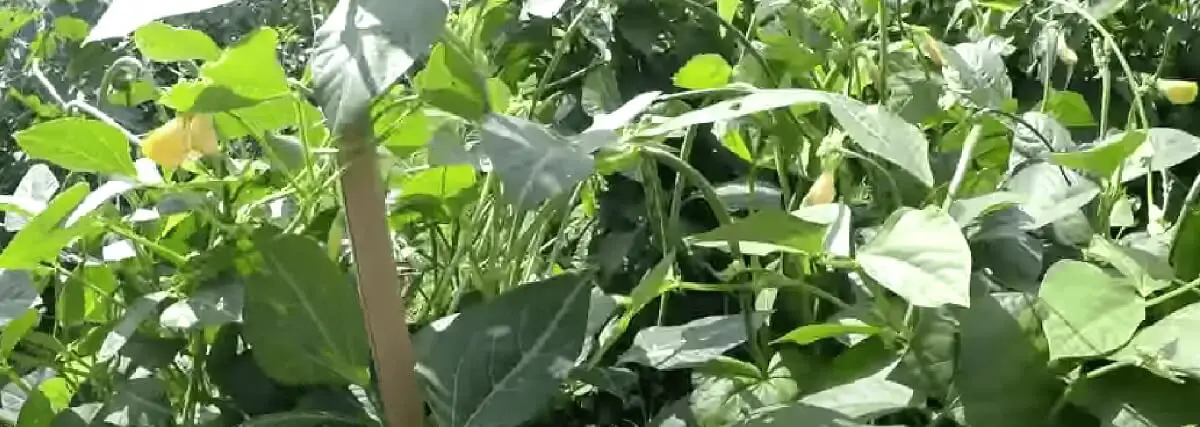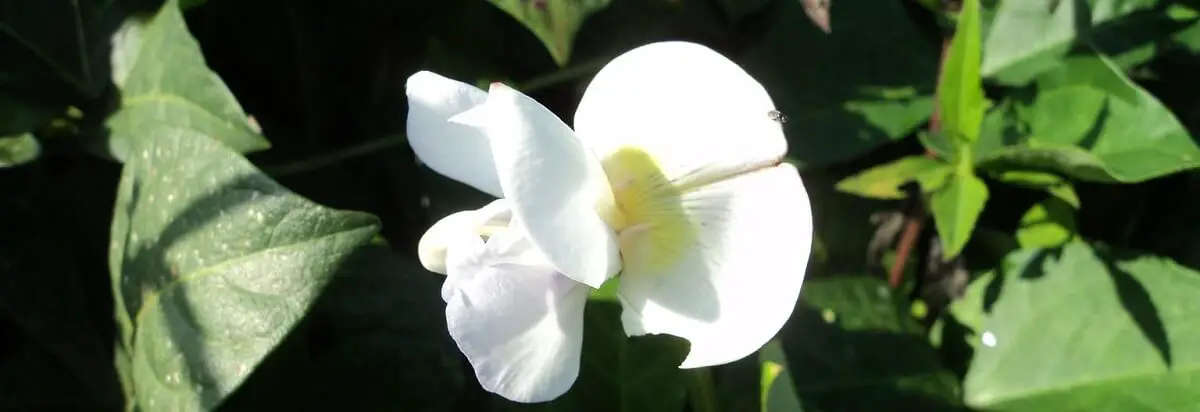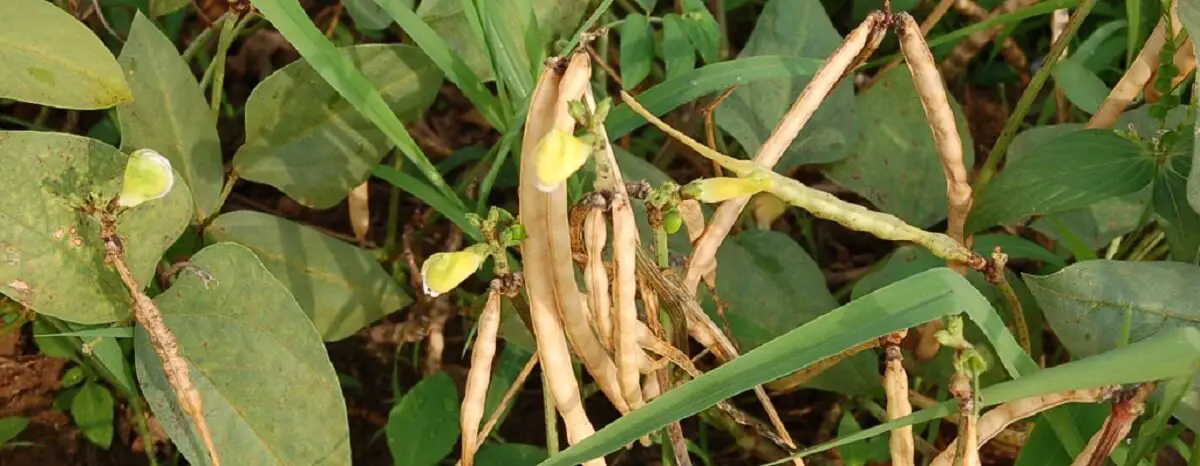Planting Cowpeas Guide What You Need To Know
Why Is Cowpeas A Good Green Manure And Cover Crop

The cowpea (Vigna unguiculata L. Walp.) is an annual legume also known as the southern pea, blackeye pea, crowder pea, lubia, niebe, coupe, or frijole.[1]
It is a summer cover crop that commonly gets used in an intercropping system.
It originally comes from Africa and grows in Latin America, Southeast Asia, and the southern United States.
In California, the blackeyed cowpea type is mainly grown and called the California blackeyed peas.
Since it is a member of the legume family, it will help to capture nitrogen in the air and place it in a usable format for our intercropped plants.
The cowpea plant will grow to a height between 24 and 36 inches (2 to 3 feet) and is very heat and drought resistant.
They are very hardy, which is why many choose them for food plots in the southern United States.
If your garden is in a southern area, you must watch out for Curculio bugs. These annoying insects will lay eggs inside the pods and, when hatched, will start feeding off the peas.
Picking your peas often will help to reduce the chances of these bugs moving into your garden.
For cowpeas to add nitrogen to our soil, there must be the Rhizobium bacteria since these convert the nitrogen into a usable plant form in our soils.
Is Cowpea an Annual Crop or Perennial Crop
Where they get planted will determine if they are an annual or perennial crop type.
In USDS zones 7 to 10, the cowpea plant is considered a perennial.
But when grown in zones 5 and 6, such as the midwest, it is produced as an annual crop.
What Do Cowpea Plants Look Like
The cowpea is an annual legume that has varying growth habits. It can be erect, trailing, climbing, or bushy, depending on its growing conditions.
Roots: the cowpea has a taproot with spreading lateral roots in surface soil.
Leaves: The cowpea plant's first pair of leaves are oppositely arranged. The remaining leaves will have an alternate pattern that is trifoliate. The leaves have a dark green color.
Stems: The stems are striated, smooth, or can have a slightly purple shade.
Flowers: The flowers on the cowpea plant have alternate pairs, with only a couple per inflorescence. They are self-pollinating with short pedicels with white, dirty yellow, pink, or purple colors on the corollas.

Pods: The pods can grow to a length of 6 to 10 inches. They will begin as a more yellowish color and turn a darker green when matured. But you can pick their pods for eating at any point in the season.

Cowpeas Planting Dates
When to Pant Cowpeas?
Most of us can get the cowpeas into the ground between early May and early August. If we plant them too early in the year, the soil warmth will not be high enough, and we will get low germination rates.
Conversely, when we plant them too late, the frost can kill them before they have matured sufficiently.
Once our soil consistently hits a temperature of 18.3°C (65°F), our seeds are ready to get planted. Consistent warm soil temperature is the best determining factor to ensure our plants germinate.
Zone 7 – July 1st to July 30th
Zone 8 – July 15th to August 15th
Zone 9 – The whole month of August
A safe bet for having your soil warm enough is to wait about four weeks after the last frost date to ensure that the ground is warm enough for the seeds to germinate properly.
Cowpeas Planting Depth
Peas are one of the few plants that do not benefit from transplanting and do great with direct planting into the plot where you will be growing them.
Plant the seeds directly into your garden between 1 and 1.5 inches deep when your soil temperature is around 18.3°C (65°F). Under 1 inch may cause birds and other animals to eat them. Keep the seeds between one to two inches distance between each seed.
What is The Best Fertilizer For Cowpeas?
You are not going to need to add any fertilizer when you are growing cowpeas in our gardens.
If you want to add fertilizer to maximize its growth, focus on fertilizer with no nitrogen, something around an npk of 0-10-10 for best results.
Adding fertilizer with a high nitrogen level will increase the growth of leaf material and reduce the yield of peas collected.
If you are intercropping with companion crops, you can add a fertilizer with an NPK of 0-10-10 to 10-10-10.
There is one thing to look out for, and that's if you notice that the leaves on the cowpea plant start to become pale. Pale leaves are a sign that they need some outside nitrogen source.
I like to use something like fish emulsion at this point to give them the extra nitrogen they need.
Cowpeas Germination Time
Multiple factors will alter how long it takes for our cowpeas to germinate. The depth that we plant, available moisture, and temperature can change the germination speed we see.
Under ideal conditions, we should see our sprouts coming up within 10 to 14 days. To see them sprout within this time, we need the soil to be around 60 to 75 degrees Fahrenheit.
They will generally still germinate in a temperature range of 40 to 80 degrees Fahrenheit. It can take 3 to 4 weeks at the lower temperature and 5 to 7 days at the higher ends. The number of seeds that sprout is reduced at these lower temperatures.
Planting Cowpeas Cover Crop
To maximize the growth of our cowpeas, we want to have our soil pH level set to a range between a pH of 5.5 to 7.5. Are soil temperature should also be warmer, around 60 degrees Fahrenheit.
Cowpeas are adapted to a wide range of soils but prefer loose well-draining soils and can develop root problems when placed in soils that are always waterlogged. When the soil is always moist, it is common for cowpeas to develop root rot and other soil-borne illnesses.
We will plant them directly into the soil about one inch deep with the eye of the seed facing downwards.
When they have germinated and are in the growing season, you will want to provide them with about one inch of water per week.
We can place dried seeds in water for a few hours to overnight to help speed up the speed that our cowpeas will germinate.
What is a Companion Plant For Cowpeas?
Before we look at good companion plants to have with our cowpeas, it's important that we don't place a couple of specific types.
Cowpeas do not do well when a plant from the Allium family gets planted with them. These are plants like onions or garlic, and they also do not do well around the gladioli flower.
Companion plant list
- Corn
- Tomatoes
- Turnips
- Parsnips
- Potatoes
- Eggplant
- Radishes
- Cucumbers
- Carrots
- Beans
- Cauliflower
- Brussels sprouts
- Broccoli
- Cabbage
Cowpeas Growth Stages
- Germination
- Seeding growth
- Late vegetative
- Early bud
- Mid bud
- Late bud
- First Bloom
- Mid bloom
- Full bloom
How Do Cowpeas Grow
They can grow in multiple ways depending on where they get planted and what is around them.
So they can end up being erect and bushy and semierect (trailing), or if placed around something like corn, they will move into being climbers.
Cowpeas as Green Manure
Cowpeas are a great way to add extra nitrogen to our garden naturally and can later get tilled into the garden or collected and used as plant material in our composting.
They also work great in an intercropping garden system.
I will still add another crop at the end of the year to help protect my soil over the winter, like winter rye. Cowpeas mainly help protect soil runoff through summer.
How Long Does it Take For Cowpeas to Mature?
It will take our cowpeas an average of 80 days to reach their full maturity from sprouting. If you choose to grow them on the vine, make sure to have a crop they can climb or use poles and fencing to help them grow.
When Are Cowpeas Ready to Harvest
When Are Cowpeas Ready to Pick
We can pick the cowpea pods throughout multiple points in their life cycle. When they reach a size between 6 to 10 inches, they have reached the maximum size they can get, and you can start picking the pods of the plant.
We don't need to wait to collect the pods until they reach full size. Once you see some pods that change in color, you can try them to find what level of maturity you enjoy the most.
We can leave them on the vine even longer to the point where the pods have dried on the vine.
So try playing around with different timing of collecting the pods to determine at what point you enjoy them the most.
Summary
Cowpeas work very well in intercropping systems to help you prevent nitrogen depletion in our soils.
We can also collect the pods for our use while adding the leftover into the soil as a source of green manure.
Many people consider legumes to be one of the best crop types to help reduce our reliance on inorganic fertilizers and improve the quality of our soils at the same time.
We mustn't put them in a spot where the moisture in the soil will stick around too long. Our cowpeas can start developing root rot and significantly slower growth if we do.
Similar Articles
Growing Scindapsus Aureum
Planting Winter Peas
Planting Crimson Clover
Planting Winter Wheat
[1]http://corn.agronomy.wisc.edu/Crops/Cowpea.aspx
[2]https://www.asiafarming.com/growing-cowpeas-cultivation-practices
[3]https://www.gardeningknowhow.com/edible/vegetables/peas/pea-plant-companions.htm
[4]https://link.springer.com/article/10.1007/BF00010174
[5]https://www.growveg.com/guides/green-manures-the-good-the-bad-and-the-ugly/
[6]https://shareok.org/bitstream/handle/11244/12625/Thesis-1996-S381u.pdf?sequence=1
[7]https://www.outsidepride.com/seed/cover-crop/cowpeas-seed.html
[8]https://www.ufseeds.com/cowpea-seed-to-harvest.html
[9]https://hosstools.com/cowpea-growing-guide/
[10]https://www.sturdybarn.com/how-long-does-it-take-for-cowpeas-to-germinate/